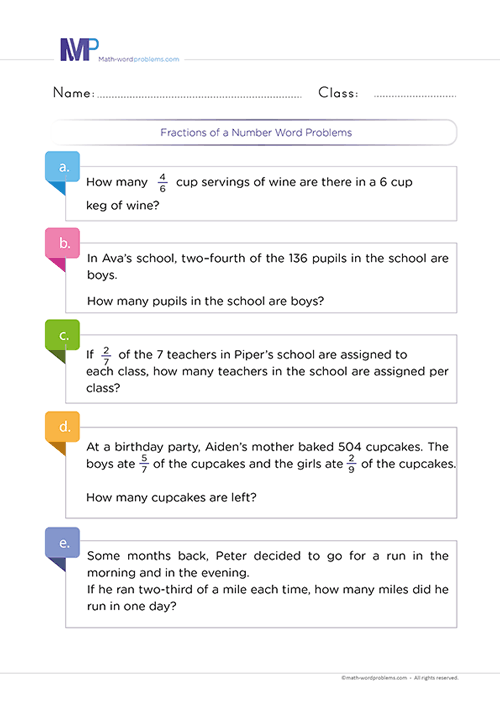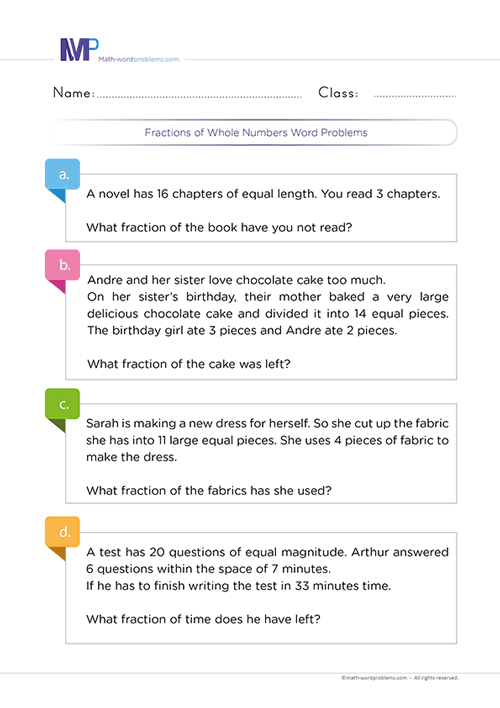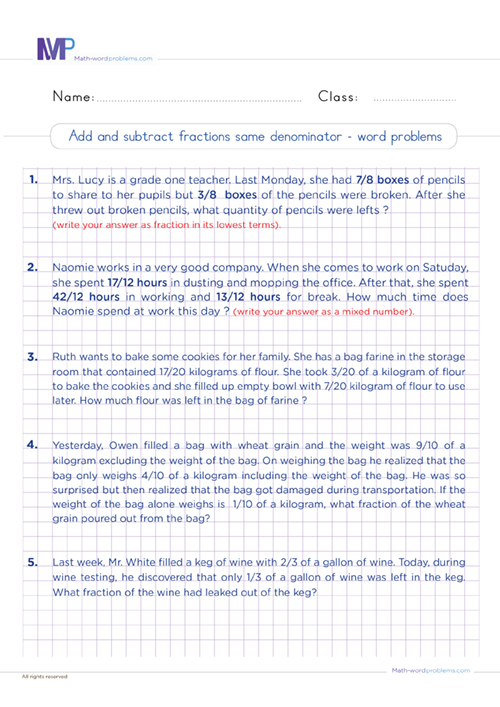 How to solve fractions of a number word problem
How to solve fractions of a number word problem
Here is a fantastic way with simple tips on how to solve fractions of a number word problem for grade 5. This step-by-step solving method will provide kids with the best techniques to solve word problems involving fractions of a number. By so doing, we hope to enhance your learners' minds with infinite knowledge.
In a particular way, this step-by-step method will focus primarily on how to read a word problem and understand what the problem wants you to do. Above all, kids will understand that they must not always rely only on the keywords found in the word problem.
Above all, we'll enable young math learners to understand that reading comprehension greatly contributes to kids' word problem-solving performance, which most tutors and learners usually ignore.
Method to solve fractions of a number word problems
Your kids will find the best method to solve fractions of a number word problem here. This method will enlighten and build up your kids' minds to fluently read, comprehend and solve any word problems on fractions of a number, irrespective of the challenge the question may pose.
We have also included some fun examples to let kids see how fascinating it is to follow our method to solve these complex word problems.
Step 1: IDENTIFY THE PROBLEM
To identify the problem, begin by finding out the situation that the problem wants you to solve. For instance, what you are looking for. You can do this by deciphering the most important keywords in the word problem.
- For instance, when multiplying fractions of a number, we need to look for common keywords such as "of," "times," "product of," "how many," "how much," etc.
Note: One key Element for learners to understand is that they should not always rely on keywords alone. That is to say; the same keyword can have different meanings in different word problems.
- For this reason, we reiterate on the importance of reading the question very carefully to understand the situation that the word problem is describing, then figure out exactly which operation to use
Step 2: STRATEGIZE OR GATHER RELEVANT INFORMATION
How will you solve or tackle the problem?
One key thing you should remember is that each word problem may require a different format. So, these key points below will help kids to solve any format however it comes accurately.
- Now, from the keyword(s) in the word problem, you will know if you need to multiply or perform any other operation.
- Also, it would be best not to rely entirely on keywords. Also, try to understand the situation that the problem is describing.
- After knowing which operation you will perform, construct short expressions/sentences representing the given word problem. This visual representation of the most vital information will make it easier to solve the word problem.
Step 3: CREATE THE EQUATION
Here, write down a numerical expression representing the information in the word problem.
Step 4: PROVIDE A SOLUTION
From Step 3 above:
- Convert the whole number into a fraction by dividing the whole number by 1.
- Secondly, multiply the numerators across and also multiply the denominators across. Note that when multiplying fractions, a common denominator is not needed.
- Thirdly, simplify the fraction if possible.
- Lastly, always include the unit of measurement in your final answer.
Step 5: CHECK YOUR WORK
To conclude, check if your answer makes sense. For instance, estimate the answer and see if it is close to what you expected. However, if the answer is not what you expected, go back to step one and start all over again.
Examples on how to solve fractions of a number word problems
Example One
Step 1: You see that the important numbers here are 17, which is the whole, and 2, which is the part. The keyword found in the word problem is“ what fraction of. “
Step 2: Now, how will you solve the problem? The situation the problem describes and the keyword(s) found in the word problem show that it is a fraction of a whole word problem. So, you have to make use of the “part,” “/,” and the “whole.”
Furthermore, after knowing what the part (numerator) and the whole (denominator) will be, form short sentences to represent the given word problem, as shown below.
- Number of chapters you have read = 2
- Total number of chapters the novel has = 17.
- Therefore, the fraction of the novel you have to read = the number of chapters you have read as the numerator (part), and the total number of chapters the novel has as the denominator (whole).
Step 3:Write down a numerical fraction to represent the bolded sentence in step 2 above. Use “/” to separate the numerator from the denominator.
Step 4: From step 3 above, simplify the fraction if necessary. In addition to this, always recall to include the unit of measurement.
So, you have read
Step 5: Finally, check if your answer makes sense. For instance, estimate the answer and see if it is close to what you expected. However, if the answer is not what you expected, go back to step one and start all over again.
Example Two
Step 1: You see that the important numbers here are 8, which is the whole, and 4, which is the part. The keyword found in the word problem is “what fraction of.
Step 2: Now, how will you solve the problem? The situation the problem describes and the keyword(s) found in the word problem show that it is a fraction of a whole word problem. So, you have to make use of the “part,” “/,” and the “whole.”
But you have to note what is being asked in the question.
The question is, “what fraction of the fabric has she NOT used?”
After knowing what the part (numerator) and the whole (denominator) will be, create short sentences to represent the given word problem, as shown below.
- Number of pieces of fabric she used to make the dress = 4
- Total number of pieces of fabric she cut up the fabrics into = 8
- Therefore, the fraction of the fabric she used = the number of pieces she used to make the dress as the numerator (part), and the total number of pieces of fabric she cut up the fabrics into as the denominator (whole).
Step 3:Write down a numerical fraction to represent the bolded statement in step 2 above. Use “/” to separate the numerator from the denominator.
Step 4:From step 3 above, simplify the fraction if necessary. In addition to this, always recall to include the unit of measurement.
You see that she used
Now, to answer our main question,
You have to subtract the fraction of fabric that she used from 1.
i.e.,
So, she has not used
Step 5:Finally, check if your answer makes sense. For instance, estimate the answer and see if it is close to what you expected. However, if the answer is not what you expected, go back to step one and start all over again.






